On October 7th, UF/IFAS Extension, working with the Florida Fish and Wildlife Commission, Florida Forest Service, USDA’s Natural Resource Conservation Service, and other partners, conducted a land management tour on the outstanding property of Gus Andrews in Walton County. Andrews is and avid and passionate quail hunter and a wildlife and landownership enthusiast. He was kind enough to open his property for a tour to showcase the management of the forest land and provide educational opportunities on optimal quail management to improve wild quail populations.
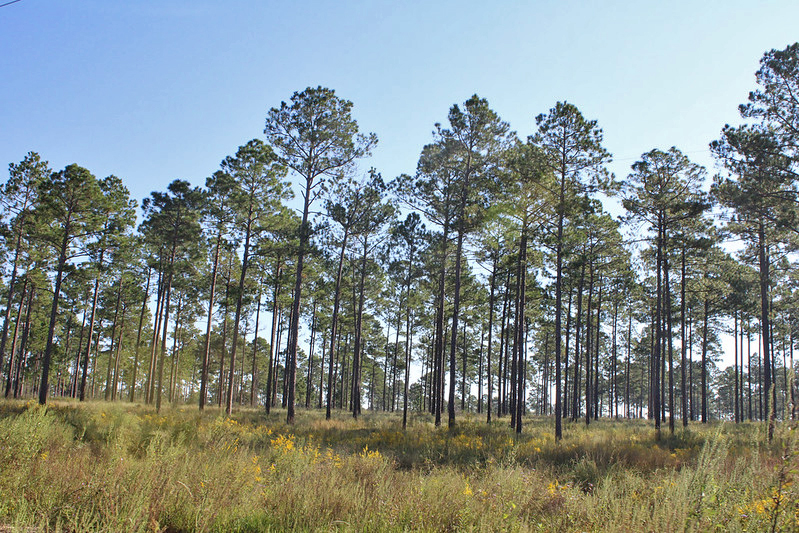
A well maintained mature stand of loblolly pine on Gus Andrews’ Property Walton County. Credit Suzette Cook, UF/IFAS
–
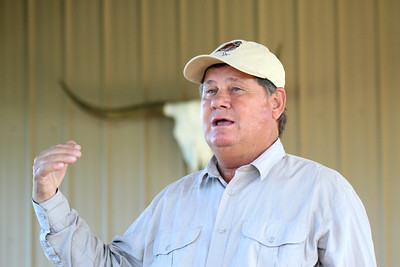
Gus Andrews Discussing the history of the property and his management outlooks on the land tour. Photo Credit: Suzette Cook UF-IFAS
Gus Andrews’ land management plan is focused on providing excellent habitat for quail, turkey, and white-tailed deer. In addition to the wildlife habitat, significant timber production is still maintained on the property. With the emphasis on wildlife, the management focus is on providing the best habitat possible, but harvesting is needed as part of the process to maintain the lower tree densities that quail prefer. Property Manager and Consulting Forester, Tim Free does an outstanding job of helping to meet Andrews goals and objectives. A highlight of the tour was that all those involved in the land management team were on site and provided outstanding information and access to the professional land managers and forestry service providers that assist Andrews in making this property a haven for quail and other wildlife, and a joy to hunt through the season.
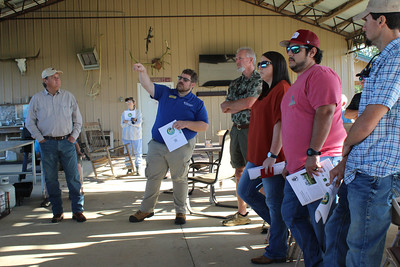
Forestry Extension Agent Ian Stone and Consulting Forester Tim Free Discuss the tour outline and property management goals with attendees. Photo Credit. Suzette Cook
With approximately 50 people in attendance, the tour was well attended and Beard Equipment generously sponsored lunch and covered other costs associated with hosting the tour. Farm Credit of Northwest Florida also sponsored the event and had representatives present. We thank our outstanding sponsors in helping make this much anticipated tour a success.
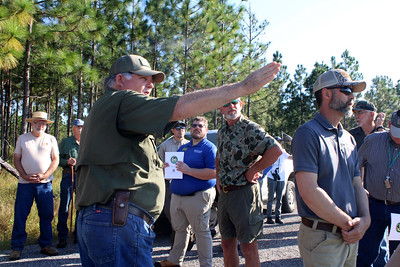
Mark Sasser from Tall Timbers discusses the finer points of bobwhite quail management with the tour. Photo Credit: Suzette Cook UF-IFAS
Mark Sasser, Alabama Quail Program Coordinator with Tall Timbers, was also on site to provide insight into the development of the property and implementation of Tall Timbers recommendations for best quail habitat. In coordination with Tall Timbers, quail call counts are conducted each year to help assess the population and plan for future management of both the habitat and population. By having accurate tracking of the population, informed hunting and harvest recommendations can be made to ensure a thriving number of coveys year after year. In areas of younger loblolly plantation, careful management through thinning and prescribed fire has helped the population of quail increase nearly 8 fold in some portions of the property. A supplemental feeding program to further assist the quail population is also conducted by scattering grain sorghum in designated areas along with careful food plot establishment and management.
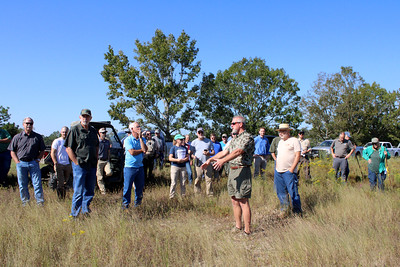
Tim Free describing forest management on Gus Andrews property tour. Photo Credit: Suzette Cook UF-IFAS
The property is a mix of primairly loblolly with some longleaf plantations at varying ages and development stages. From newly planted longleaf seedlings to established loblolly stands over 20 years old. The property holds many forest conditions but is predominantly former commercial loblolly pine plantations. Through very careful timber management and an aggressive prescribed burning program; the forest conditions have been steadily shifted to the best conditions for the desired wildlife. Tim Free, professional forester, provides the skills and talent to design quail brood fields that fit well into the timber management needs. Converting old logging decks, which require some work up front, to make excellent habitat openings between timber harvest. Through careful disking and mowing schedules native species such as ragweed, grasses, and forbs are encouraged while not disturbing nesting and chick rearing during critical times of the year. Throughout the tour the discussions and talks highlighted how assembling a land management team is critical to large property management and successfully meeting goals and outcomes. This includes both private forestry service providers, technical experts, like those from Tall Timbers and UF/IFAS, and public agency assistance providers such as Florida Fish and Wildlife (FWC) private land biologists and Florida Forest Service (FFS) county foresters. Gus Andrews takes full advantage of cost share program conservation funds to partially fund his overall wildlife conservation management plan.
This tour was an excellent highlight of how you can meld forest management to meet a specific goal, such as optimal quail habitat while maintaining timber as a resource as well. Most people may be under the impression that loblolly is not suited to wildlife or other habitat conditions, but when carefully maintained, any of the southern pines can produce great stands that can be optimized to meet multiple objectives. While longleaf forests are usually what first comes to mind with quail management, Andrews and his land management team have shown you can optimize loblolly to meet the need as well. The Andrews’ property is an excellent example of how to work with what you have on site and but still move towards your desired outcomes. When Andrews acquired the property over two decades ago from a manger with commercial timber interests, the plantations were optimized soley for high yield timber production. By thinning heavily and managing at lower densities, the timber overstory could provide the conditions needed for the groundcover quail crave. The introduction and management through prescribed fire and careful herbicide use where needed was able to eliminate undesirable thick woody brush and shrubs. Over time the grassy understory took hold and is well maintained today.
Special thanks to Mr. Gus Andrews for generously opening his property to provide this tour. Sincere appreciation is due as well to Tim Free, Mark Sasser, Ed O’Daniels (FWC Private Lands), and Ari Sewell (FFS County Forester) for their support and assistance in planning and conducting the tour. Suzette Cook, photographer with UF/IFAS Florida Land Seward, documented the tour in pictures. I would like to thank all involved for making the tour such a success. The information provided and impactful examples of how targeted and well planned forest management can produce an outstanding property are lessons well learned and shared.
- Recent Drought Conditions Increase Pine Bark Beetle Risk - October 31, 2025
- Panhandle Landowner Assistance Expo – August 23 - July 11, 2025
- Tick Prevention – An Important Safety Measure When Working Outdoors - April 25, 2025
